From Swan Island to Belle Isle: Land as it Changes Hands
Introduction
Text-to-speech Audio
Images
1. Gordon L. Grosscup Museum of Anthropology, Belle Isle Collection: Faunal - Rib and Vertebra. "Imagine the size of an animal with these bones. Could these remains be leftover from a chicken, pig, or deer that once roamed freely on Belle Isle? Or perhaps, a coyote that snuck itself onto the island in search of food…"
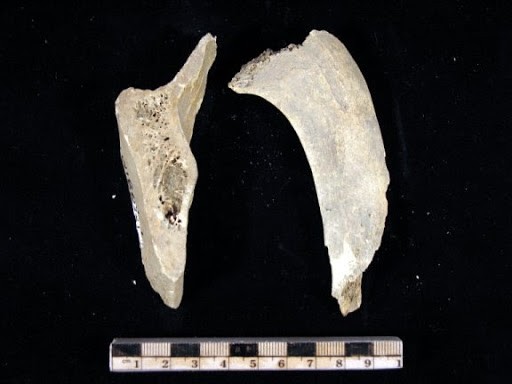
2. Detroit Public Library, Burton Historical Collection: View of Deer in Wooded Area on Belle Isle. "The Ojibwe were thankful for all animals and showed their respect by using every part of them for things like food, clothing, tools, and more… Hunting, fishing, and gathering were all common practice for the Anishinaabe tribes. The deer native to Belle Isle were likely hunted by Indigenous people."
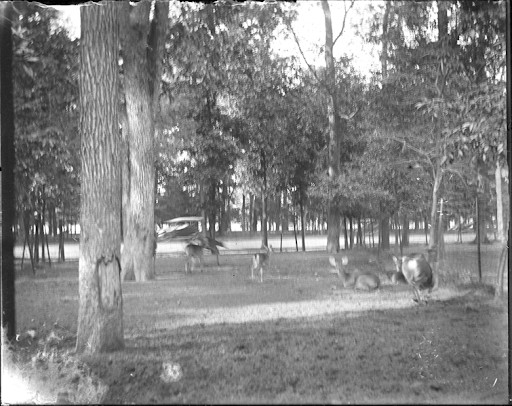
3. Detroit Public Library, Burton Historical Collection: A beaded Belt Among Goods Used to Seal the Deal for Detroit’s Belle Isle, dated 1768. "Wampum belts convey complex information within their intricate handmade designs, sometimes differing in meaning on the front versus the back. They could be offered as a sign of peace after war… Think about what messages these beads and strings may hold, pictured next to the deed to Belle Isle."
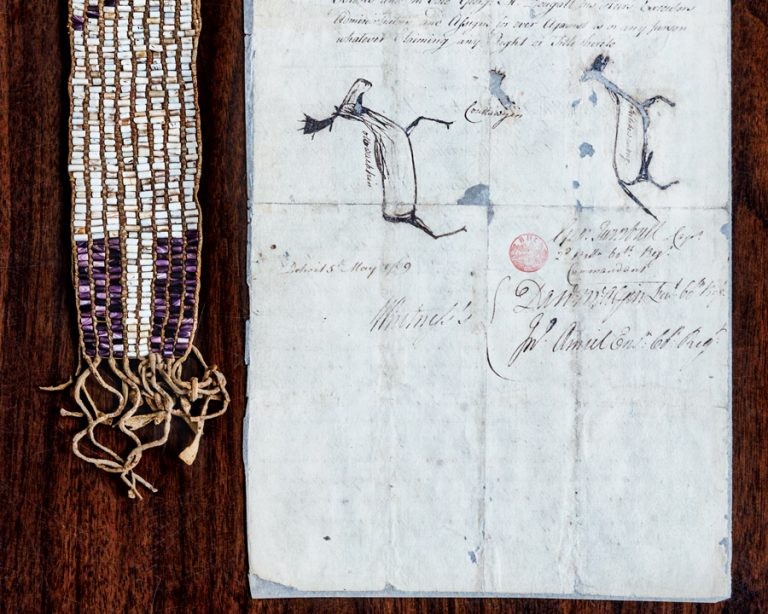
4. Detroit Public Library, Burton Historical Collection: Deed to Belle Isle, dated 1768. “The year is 1768, the island now known as Belle Isle was just purchased from the Ottawas and Ojibwa tribes by Lieutenant George McDougall. Detroit citizens are displaced from once public land in exchange for eight barrels of rum, three rolls of tobacco, six pounds of vermillion and a wampum belt.”
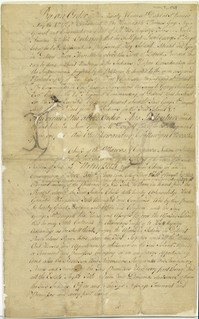
5. National Park Service, "Pig Island" (Île aux Cochons) on a French map, dated 1796. “Before Belle Isle had bridge access in the 1900s, people could only get to it by boat. French colonizers must have ridden along with the livestock they brought to the island… Imagine the cleanliness, or lack thereof, on a boat shared with animals.”
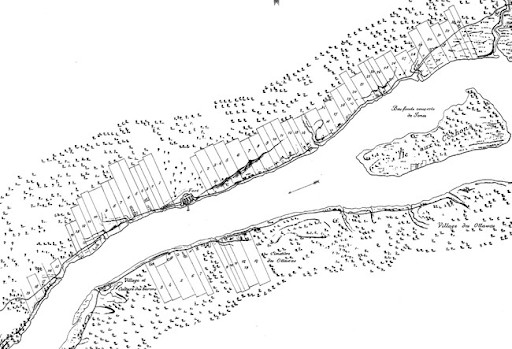
6. The Alexander Macomb Monument at the Corner of Michigan Avenue and Washington Boulevard, in Detroit. Photographed by Rodney Coleman-Robinson, Detroit Free Press. "An American officer and colonist once commended for his part in the War of 1812. Also, the private owner of Belle Isle and the largest slaveholder in Michigan at the time… An island far different than the welcoming recreational retreat it is today."
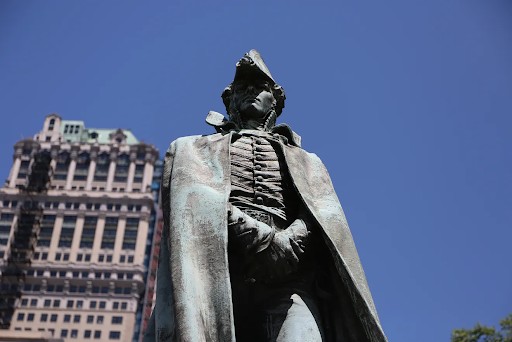
7. Barnabas Campau Gravestone, in Mount Elliott Cemetery, dated 1845: “A French colonizer, slave owner, and private who partook in the War of 1812: Campau bought Hog Island before it became known as Belle Isle. Fortunately, his descendants sold it to the city of Detroit and the land has been enjoyed by a diverse public ever since.”
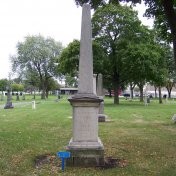
8. Gordon L. Grosscup Museum of Anthropology, Belle Isle Collection: Transfer Print with Flower Decals, dated 1900-1915. “Notice this ceramic shard’s playful floral decals, reminiscent of late spring. With Belle Isle recently declared public land by the city of Detroit, families begin to picnic along its shores. A child lost in play breaks the object… Leaving bits and pieces buried in the sand.”
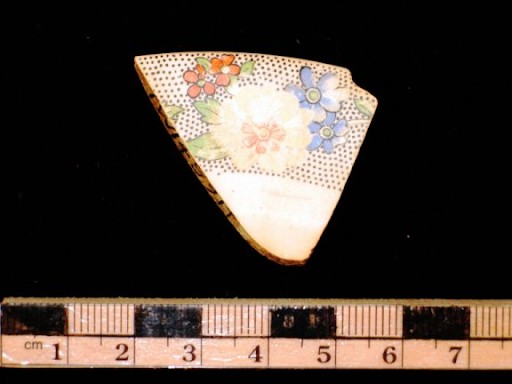
9. Detroit Public Library, Burton Historical Collection: Family Picnic on Belle Isle. Handwritten on Back: "Picnic on Belle Isle,” by Harvey Jackson, 1876-1957. “The city of Detroit has opened Belle Isle to the public. Friends and families joyfully flock to its shores to enjoy various recreational activities like picnicking, swimming, fishing, and more. Consider what season this photo was taken in, look closely at the trees and choice of clothing for clues.”
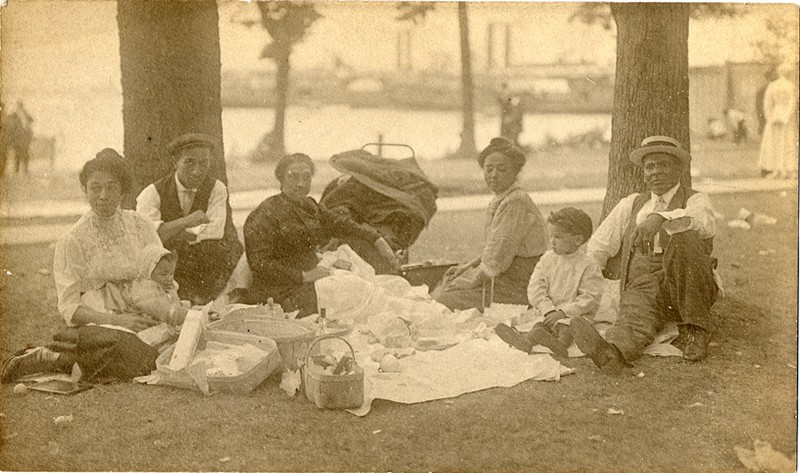
10. Detroit Public Library, Burton Historical Collection: View at an Angle of Belle Isle Aquarium and Adjoining Horticultural Hall. “Architect Albert Kahn designed these two beautiful buildings that opened on Belle Isle in 1904. Unfortunately, they had to be closed for several years during the city’s economic crisis in 2005 but they reopened in 2012. People may visit for educational purposes, photoshoots, weddings, and relaxing days spent with friends.”
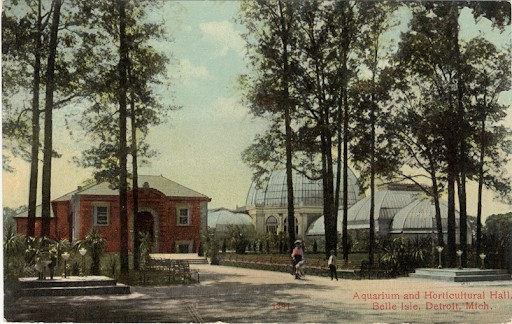
Backstory and Context
Text-to-speech Audio
Anishinaabe Tribes and French Colonizers, Public Land, (early 1700s to 1768):
Images 1-3:
Belle Isle, an island where recreational activities take place: inviting the Detroit community to spend hot summers basking in the sun and taking dips in the river. While these same activities may have been enjoyed in the past, the island used to be a much less inviting place for many. There were battles, fires, and fights over claims to the island. Not much is known about the time period when certain Anishinaabe tribes settled on the land in what we now know as Detroit, Michigan. There are no records of how long they had been using the island before colonizers took over and displaced them. One wonders what it may have been like on the island before years of landscaping and construction altered its original state of natural beauty.
In its earliest known days, Belle Isle was known as “Wah-na-be-zee” or Swan Island by the Indigenous people who lived there. This was back in the early 1700’s, the lesser publicized period of time where the Anishinaabe Ottawa and Ojibwa tribes settled upon and tended to the land which is now named Belle Isle and owned by the city of Detroit. It’s a complicated history, since Indigenous Anishinaabe people claim to have never believed it possible to “own” any piece of land: they had a complex relationship with the natural world. The name Swan Island itself is said to have come from their reverence for the swans that migrated there each year. Eventually, more people came to Detroit to settle upon the land alongside the Ottawa and Ojibwa people. It was later called “Ile Aux Cochons'' or Hog Island by the French colonists who allowed their livestock to roam freely there. It is important to note that the land of Belle Isle was also briefly involved in Pontiac’s Rebellion, while Chief Pontiac managed to conquer it for some time, it inevitably fell into British ownership.
British, French, and American Colonizers, Private Land, (1768 to 1879):
Images 4-7:
This period of history surrounding Belle Isle is the darkest that we know of: it’s riddled with recorded racism and abuses of power by those who owned the island after the Indigenous people were forced out. Most of the owners from this point until the city of Detroit took possession of the island were notable slaveholders. Due to their privatization of the land for personal use, there is little we know about what went on during this time. It’s expected that the people living here continued to enjoy the many natural aspects of the land but it’s hard to think about what went on behind closed doors. It is not often that people talk about the fact that slavery existed in Detroit, but recently this history has begun to be uncovered more publicly, and people are questioning the monuments of racist war heroes standing watch over the streets.
In 1768, Lieutenant George McDougall “occupied” the land after being given permission to do so by King George III. Shortly after, he purchased the land from Ottawa and Ojibwa tribes, displacing citizens and their livestock, and then in 1777, McDougall took full possession of the island. After the war of 1812 however, American General Alexander Macomb, Jr. took ownership of the land, using it for his own private estate. In 1817, Barnabas Campau purchased the island where he built a summer home that is currently in use as office space by Detroit’s Parks and Recreation Department. Only in 1845, during a historic picnic event, was the island officially named “Belle Isle” or Beautiful Island, in honor of Governor/General Lewis Cass' daughter, Isabelle Cass.
The City of Detroit, Open to the Public Once Again, (1879 to present):
Images 8-10:
A bridge built to connect the island to the mainland of Detroit. A zoo teaming with polar bears, deer, and monkeys. An aquarium adjacent to a conservatory, a museum, nature center, yacht club, boathouse, casino, and lighthouse. Race riots, U.S. Military, financial troubles, and more. Since Detroit took ownership of Belle Isle, the island and its surrounding community have had their fair share of ups and downs. Some of the park’s man made attractions have come and gone but most of them have made it out relatively unscathed. It continues to exist as a public recreational state park area, and a place that many community members can happily call home throughout Michigan’s warmer months.
It was after many years spent as private land, in 1879 that Barnabas’ heirs sold Belle Isle to the city of Detroit, and the following year it was made public land once again. Belle Isle is currently the country’s largest city island park and has officially been recognized as a state park since 2014. It continues to be a beautiful area full of natural wonders and unmistakable Detroit architecture. Only time will tell what attractions will be added to the park next. Hopefully, it will continue to stay public land for endless years to come.
Sources
Detroit Historical Society. Encyclopedia of Detroit: Belle Isle Park, Detroit Historical Society. Accessed November 9th 2020. https://detroithistorical.org/learn/encyclopedia-of-detroit/belle-isle-park#:~:text=Belle%20Isle%20is%20a%20recreational,the%20public%20the%20following%20year..
Gillespie, Deborah. The Campau Family, Sibley House Detroit. November 2012. Accessed November 7th 2020. http://sibleyhousedetroit.com/the-campau-family/.
History Detroit. Detroit Places: Belle Isle, History Detroit. Accessed December 11th 2020. http://historydetroit.com/places/belle_isle.php.
McGraw, Bill. Slavery Is Detroit's Big, Bad Secret. Why Don't We Know Anything About It?, Deadline Detroit. August 27th 2012. Accessed December 8th 2020. https://www.deadlinedetroit.com/articles/1686/slavery_is_detroit_s_big_bad_secret_why_don_t_we_know_anything_about_it.
National Park Service. Native American History in Detroit, National Park Service. August 30th 2020. Accessed December 8th 2020. https://www.nps.gov/articles/000/native-american-history-in-detroit.htm.
De Beausset, Kyle Alexander. I'm a Direct Descendant of Gen. Alexander Macomb. It's Time to Take His Statue Down. | Opinion, Detroit Free press. June 19th 2020. Accessed December 8th 2020. https://www.freep.com/story/opinion/contributors/2020/06/19/take-down-gen-alexander-macomb-statue-detroit-descendant-says/3222280001/.
1. http://www.clas.wayne.edu/anthromuseum/Belle-Isle
2. https://digitalcollections.detroitpubliclibrary.org/islandora/object/islandora%3A161199
3. https://www.hourdetroit.com/community/weaving-detroit-history-together/
4. https://digitalcollections.detroitpubliclibrary.org/islandora/object/islandora%3A131799
5. https://www.nps.gov/articles/000/native-american-history-in-detroit.htm
6. https://www.freep.com/story/opinion/contributors/2020/06/19/take-down-gen-alexander-macomb-statue-detroit-descendant-says/3222280001/.
7. http://sibleyhousedetroit.com/the-campau-family/
8. http://www.clas.wayne.edu/anthromuseum/Belle-Isle
9. https://digitalcollections.detroitpubliclibrary.org/islandora/object/islandora%3A161606
10. https://digitalcollections.detroitpubliclibrary.org/islandora/object/islandora%3A138894
